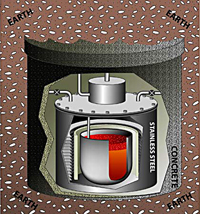By Dave Maass
Published: November 21, 2007
The portable nuclear reactor is the size of a hot tub. It’s shaped like a sake cup, filled with a uranium hydride core and surrounded by a hydrogen
 Invented by scientist Otis Peterson, Hyperion’s patent for a hydride reactor is still pending. |
atmosphere. Encase it in concrete, truck it to a site, bury it
underground, hook it up to a steam turbine and, voila, one would generate
enough electricity to power a 25,000-home community for at least five years.
The company Hyperion Power Generation was formed last month to develop the
nuclear fission reactor at Los Alamos National Laboratory and take it into
the private sector. If all goes according to plan, Hyperion could have a
factory in New Mexico by late 2012, and begin producing 4,000 of these
reactors.
Though it would produce 27 megawatts worth of thermal energy, Hyperion
doesn’t like to think of its product as a “reactor.” It’s self-contained,
involves no moving parts and, therefore, doesn’t require a human operator.
“In fact, we prefer to call it a ‘drive’ or a ‘battery’ or a ‘module’ in
that it’s so safe,” Hyperion spokeswoman Deborah Blackwell says. “Like you
don’t open a double-A battery, you just plug [the reactor] in and it does
its chemical thing inside of it. You don’t ever open it or mess with it.”
LANL scientist Otis Peterson filed the patent for the nuclear fission
reactor in 2003. In theory, the reactor uses uranium crystals and hydrogen
isotopes to create an internal, self-regulating balance. Because it’s so
new, anti-nuclear power activists aren’t quite sure what to make of it yet.
But ‘skeptical’ is perhaps too gentle a word for their initial reactions to
Hyperion’s claims of a “clean” energy source.
“This whole idea is loony and not worthy of too much attention,” Los Alamos
Study Group Executive Director Greg Mello says. “Of course, factoring in
enough cronyism, corruption and official ignorance and boosterism, it’s
possible the principals could make some money during the initial stages,
before the crows come home to roost.”
The Federal Laboratory Consortium for Technology Transfer would beg to
differ. The group of 700 labs, set up by Congress to promote “technology
transfer” activities between the public and private sectors, honored
Peterson’s invention as an “Outstanding Technology Development” in October
2003 at its conference in Hawaii. Now retired from LANL, Peterson has become
the chief scientist for Hyperion, Blackwell says.
Blackwell is a director of Purple Mountain Ventures, a self-described
“adventure capital” firm specializing in commercial development of LANL
technology. Purple Mountain also is the financial backer behind The Company
for Information Visualization and Analysis (CIVA), a local company
developing LANL pandemic modeling software. Hyperion’s reactor, though, has
the potential to solve the energy crisis, according to Blackwell.
“The lab is doing a lot of work on oil shales and oil sands, but there’s no
way to get power to those facilities,” Blackwell says. “So, this nuclear
battery would be brought in and that would provide the power to run a small
city of industrial use.”
Blackwell also envisions that the battery could be used at military bases,
as well as in the developing world, where poverty is a product of a lack of
electricity and clean drinking water. This week, Hyperion meets with its
first potential clients, but Blackwell hopes to approach the United Nations
and international humanitarian groups.
So far, though, anti-nuclear advocates don’t buy the claims advertised on
Hyperion’s Web site (www.hyperionpowergeneration.com).
“The nuclear industry has never given the complete picture.” Nuclear Watch
New Mexico Executive Director Jay Coghlan says. “Taxpayer subsidies and the
environmental and financial costs of mining and enriching uranium and waste
disposal are never completely factored in.”